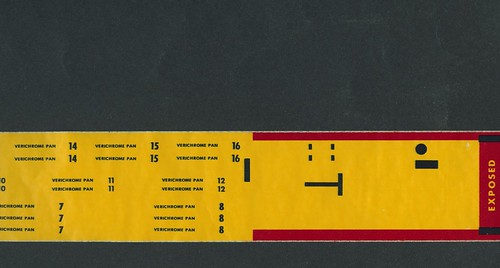Last week I posted frames processed from a roll of Verichrome Pan that was in a Kodak Bantam 828 when I bought it. This pocket-sized folding camera, produced in 1935, was designed by Walter Dorwin Teague, who also designed the wonderful Beau Brownie series for Kodak. The Bantam comes with a fixed f6.3 Anastigmat lens and a shutter release placed at the bottom of the from plate of the bellows - a placement I wasn't used to, so that I couldn't figure out where the shutter release was at first. I got an unopened roll of Verichrome Pan eBay and ran it through the handsome maw you see right there.
The film expired in 1969, but I've gotten good images from VP stock even older than that. Still, I thought I'd have to cancel this week's vintage camera post and write up the iPhone camera - which, under the guise of sundry Hipstamatic "lenses" and "films," I've been using more than any other camera lately. The lab returned my film without printing anything, and held up to sunlight I couldn't argue with their judgement of what looked like black frames. But upon further examination, there were trace images on about half of the eight-exposure roll, and my Epson 4990 scanner did the rest. One of these scans seems to explain why the negatives look so dark (which, inverted, means the film is too bright, and was seriously over-exposed).
The black horizontal bands near the top of the frame look like ghosts from the film's backing paper. I think I should have taped up the frame window in the back of the camera. This is the back of the Kodak Bantam.
To this day, roll film is printed with backing paper that has a series of frame numbers on the back. This is what the backing paper from a roll of VP 620 looks like:
The numbers line up with a window in the back of the camera, and depending where that window is placed you get the frame alignments for square or rectangular pictures, whichever the camera is made for. On the above roll, for instance, you can get 16 square frames, 12 4x5 (I think?) frames, and 8 6x9 frames. The plastic windows that reveal these numbers can let in light even under the best of circumstances, and when the red plastic fades, as I think it did in the Bantam, you're pretty much shooting naked. Next time I'll remember to tape up the frame window, as I do with my Holgas and, pictured below, my moldy Brownie, about which I'll write more soon:
Anyway, I could only recognize one image on this roll of fogged film, and not coincidentally, it was one I shot on an overcast day, near dusk. It's the C&O canal in Georgetown:
In other vintage camera news, comedian, hero, American, Chris Elliott, in this clip from his late great Fox sitcom Get a Life, enters scene one with what appears to be a Brownie Holiday:
Later in the episode, a press gaggle hauls out their Speed Graphics. I don't have one of those, but I'll show you my Brownie Holiday later.






No comments:
Post a Comment